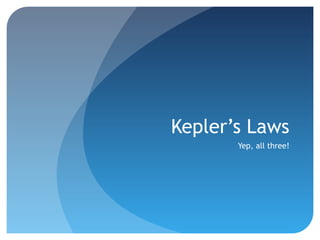Keplers laws
•Download as PPT, PDF•
0 likes•435 views
The document discusses the history of models of the solar system from ancient Greek astronomers to Johannes Kepler. It describes how Greeks originally believed in a geocentric model with the Earth at the center, which was later supported by Ptolemy. Copernicus then developed the heliocentric model of the sun at the center. Galileo's observations of Jupiter's moons and use of the telescope supported this model. Tycho Brahe and Kepler collected extensive observational data, allowing Kepler to develop his three laws: planets orbit in ellipses, their speed changes as they revolve with closer planets moving faster, and their orbital period relates to their average distance from the sun.
Report
Share
Report
Share

Recommended
Recommended
More Related Content
What's hot
What's hot (20)
Viewers also liked
Viewers also liked (12)
Similar to Keplers laws
Similar to Keplers laws (20)
Professor’s Questions Set 2Provide comprehensive answers to th.docx

Professor’s Questions Set 2Provide comprehensive answers to th.docx
physical science senior high school Q2 WEEK 1.pptx

physical science senior high school Q2 WEEK 1.pptx
More from MrsKendall
More from MrsKendall (17)
Isotopes, Lewis Dot Diagrams and Predicting Reactions

Isotopes, Lewis Dot Diagrams and Predicting Reactions
Recently uploaded
APM Welcome, APM North West Network Conference, Synergies Across Sectors

APM Welcome, APM North West Network Conference, Synergies Across SectorsAssociation for Project Management
Recently uploaded (20)
Contemporary philippine arts from the regions_PPT_Module_12 [Autosaved] (1).pptx![Contemporary philippine arts from the regions_PPT_Module_12 [Autosaved] (1).pptx](data:image/gif;base64,R0lGODlhAQABAIAAAAAAAP///yH5BAEAAAAALAAAAAABAAEAAAIBRAA7)
![Contemporary philippine arts from the regions_PPT_Module_12 [Autosaved] (1).pptx](data:image/gif;base64,R0lGODlhAQABAIAAAAAAAP///yH5BAEAAAAALAAAAAABAAEAAAIBRAA7)
Contemporary philippine arts from the regions_PPT_Module_12 [Autosaved] (1).pptx
Micromeritics - Fundamental and Derived Properties of Powders

Micromeritics - Fundamental and Derived Properties of Powders
Introduction to ArtificiaI Intelligence in Higher Education

Introduction to ArtificiaI Intelligence in Higher Education
Science 7 - LAND and SEA BREEZE and its Characteristics

Science 7 - LAND and SEA BREEZE and its Characteristics
APM Welcome, APM North West Network Conference, Synergies Across Sectors

APM Welcome, APM North West Network Conference, Synergies Across Sectors
Hybridoma Technology ( Production , Purification , and Application ) 

Hybridoma Technology ( Production , Purification , and Application )
Keplers laws
- 1. Kepler’s Laws Yep, all three!
- 2. Greek Observations Early Greeks were the first to truly notice the planets in our solar system. In fact, planets is Greek for wanderers. Greeks believed that the earth was spinning within a larger dome called the celestial sphere. Greeks believed in a geocentric model, where the earth is at the center.
- 3. Ptolemy (Greek astronomer) Ptolemy believed, as other Greeks did, that Earth was at the center; however, he hypothesized that the planets were moving on flat planes. The Geocentric model was accepted as truth for nearly 1,500 years!
- 4. Copernicus’s Revolution! Polish Astronomy, Nicolaus Copernicus helped to develop the heliocentric model, where the sun is at the center rather than the Earth. Many people had trouble accepting this model, even into the 1600’s!
- 5. Good old Galileo Galilei Because Galileo use the newly invented telescope, he was able to discover more than his predecessors. Galileo discovered 4 moons orbiting Jupiter (known as the Galilean Moons) Galileo also helped to support and develop the heliocentric model.
- 6. Tycho Brahe & Johannes Kepler Late 1500’s, Danish astronomer Tycho Brahe and his assistant Johannes Kepler worked over a 20 year period collecting data through observations of the night’s sky. After Brahe died in 1601, Kepler continued to analyze and study the data- from that came his 3 laws.
- 7. Kepler’s 1st Law Through his observations of Mars’s orbit, he discovered his first law: The Orbital path of the planets are NOT circular- they are an ellipse (oval shape). This discovery disproved the long help belief of circular orbits.
- 8. Kepler’s 2nd Law Kepler then discovered that the speed of a given planet changes as it revolves around the sun. The closer a planet is to the sun, the faster it moves. The farther away it is, the slower it moves.
- 9. Kepler’s 3rd Law Kepler also discovered that the time it takes a planet to orbit the sun and it’s average distance from the sun are directly related. The closer a planet is to the sun, the faster it’s revolution. The farther a planet is, the slower the revolution.
- 10. Kepler’s 3rd Law Kepler also discovered that the time it takes a planet to orbit the sun and it’s average distance from the sun are directly related. The closer a planet is to the sun, the faster it’s revolution. The farther a planet is, the slower the revolution.